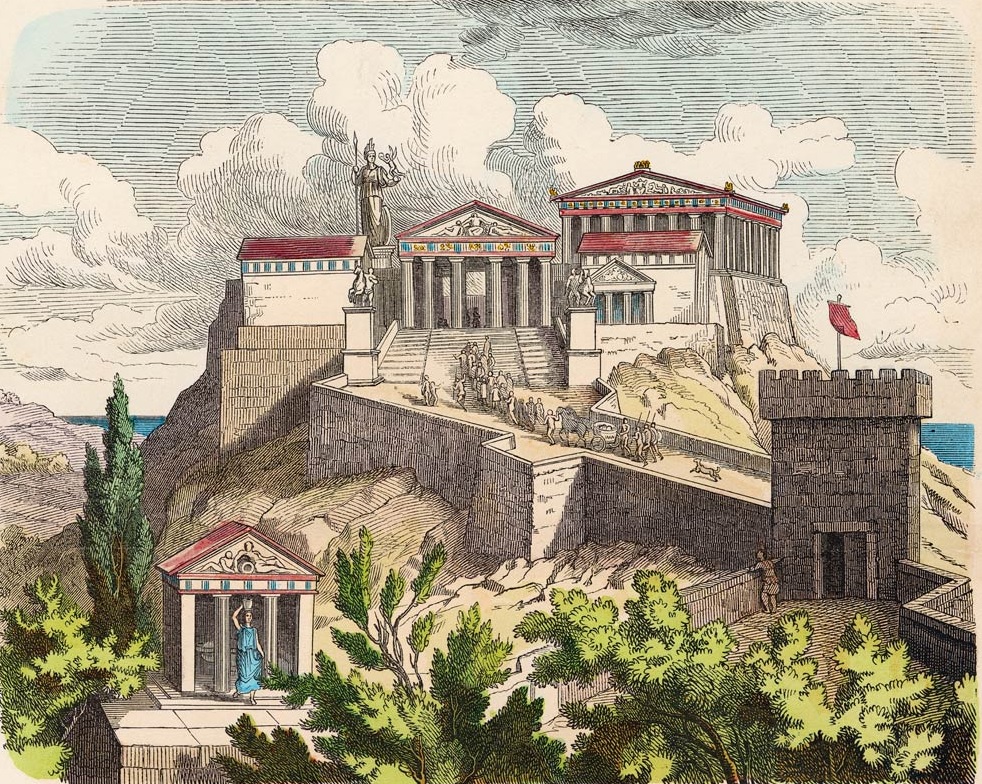Acropolis
The Acropolis, in Athens, is a small limestone hill rising to a height of 500 ft. above the sea; in ancient times, it was the holiest shrine of the Goddess Athena. It's been occupied continuously since the late Stone Age, perhaps from 4000 BC, but from the first three millennia of this long period hardly anything remains but some of the pottery and tools used by those who lived there. At the end of the Bronze Age, c.1200-1100 BC, when Athens was threatened by invasions from the north, the hill was surrounded by a massive wall of Cyclopean masonry, resembling the walls at Tiryns and Mycenae. This wall dates from the time of Theseus, the Athenian hero in Greek legend who overcame the Cretan minotaur, and who as king of Athens united all of Attica under his sceptre.
Early Ruins
The early citadel had a fortified entrance at the west and a postern gate on the northeast side. An abundant water supply was provided by a concealed fountain, reached through a cleft in the rock by a curiously constructed stairway. The water level was 110 ft. below the Acropolis.
The fortification wall, many times rebuilt, was formidable, and so high as to shut out the view except at one point at the southwest corner. When the Persians attacked the Acropolis in 479 BC, they were unable to gain possession of it by direct assault, although it was defended chiefly by old men. In the end, the Persians effected an entrance only by secret stairs originally built to reach the underground fountain. The citadel was then sacked, the temples were plundered and burned, the whole area reduced to ruins, and the early Parthenon, then in the course of construction, was destroyed by heat from the burning scaffold the Persians had built during the siege. When the Greeks returned after their victory over the Persian fleet at Salamis, they rebuilt the wall using the unfinished column drums of the temples as facing the north side, where they still remain.
For the next thirty years there was little building activity on the Acropolis, but beginning in the middle of the 5th century BC, a series of new buildings were erected of Pentelic marble (from Mount Pentelicus). The four buildings described in the following paragraphs, together with minor monuments and statues, were constructed between 450 and 400 BC, and at this time the citadel received the general character it retained until the end of the Classical Era. The thirty years, c.460-430, during which the personality of Pericles was dominant, constitute the Golden Age of ancient Athens.
The Propylaea
The principle entrance to the Acropolis is on the west, through a monumental gateway of marble called the Propylaea. The present building, erected over the ruins of an earlier entrance and designed by the architect Mnesicles, was begun in 437 BC and was almost finished five years later. The gateway proper consists of five openings for doors, the central one having a width of nearly 14 ft. The facade is in the form of a Doric colonnade with six columns approached by four steps, the lowest one of which is of dark grey limestone from Eleusis.
There is a similar colonnate on the inner side, facing the Acropolis, and a broad ramp leading through the centre of the building is flanked by three Ionic columns on either side. To the north and south of the west facade are two wings, each approached through three Doric columns of smaller dimensions than those of the main facade. The northwest wing was used as a picture gallery.
Mnesicles' original plan called for a building much larger than the one constructed, but the growing opposition to Pericles' progressive policies and the outbreak of the Peloponnesian War in 433 BC, probably caused the curtailment of his plan, and the building remains an unfinished masterpiece of architecture.
To the south and west of the Propylaea (on the right hand side in the image shown) stands the small marble temple of Athena Nike, popularly known as the temple of Nike Apteros, or Wingless Victory. It has four Ionic colums at either end which support the architrave, and above this is a frieze sculpted in relief with scenets of mythological and historical battles. The plans of this building were originally made by Callicrates after the middle of the 5th century BC. Beneath the marble temple are the remains of an earlier, much smaller shrine and an archaic altar, showing the high antiquity of the cult of Athena on this spot. A sculptured parapet of marble surrounds the bastion on three sides, and on all of the preserved slabs there are carved figures of winged victories in a variety of poses.
